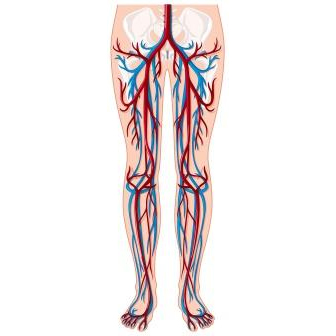
Overview
Shira is a term used collectively for blood vessels (the arteries, the veins and the capillaries). In simple language, shira denotes the circulatory system which includes arterial system as well as venous system. Preliminary knowledge of shira is very important for physicians as well as surgeons. The blood-vessels are integral part of the circulatory system that plays important role in transportation of blood in the human body.
Cardiovascular System
The heart is a conical shaped organ placed in between the lungs. The heart divided by a septum into two halves (the atria and ventricles). These are divided into left and right halves by grooves. The right part of the heart contains impure blood, the left, pure blood. From the left ventricle, the arterial blood is carried into a large artery, the aorta except the lungs. The venous blood is collected from the vein and returned to the right atria of the heart. From here the blood enters into the right ventricles then to through the pulmonary artery to the lungs. In the lungs the venous blood becomes oxygenated and finally supplied to left atria through the pulmonary vein.
To maintain unilateral direction of blood flow special structures known as valves are present in the blood vessels. Blood supply of the heart is very rich. It is supplied by right and left coronary artery.
The Heart has Three Coverings
- The pericardium is a sac in which the heart and greater blood-vessels (originating from the heart) are contained.
- Endocardium is a thin membrane which lines the internal surface of the heart.
- Myocardium consists of bands of muscle-fibers.
Classification of Shira (Blood-Vessels)
The cardiovascular system comprises of the heart and blood-vessels with their contained fluid, blood. The heart is basically a muscular organ pumping blood to all parts of the body by its contraction.
- Pure or oxygenated blood is carried by the arteries away from the heart,
- Impure or deoxygenated blood is carried by by the veins. The veins carry the blood from the capillaries back toward the heart,
- There is another group of blood vessels known as capillaries which carry lymph. The capillaries ensure the exchange of chemicals and water between the blood and the body-tissues.
Shira according to Sushruta Samhita (Blood-Vessels)
Sushruta, the great Indian surgeon, has given a distinct description of veins, artery and srotas (channels of circulation). If studied minutety, the term shira, at one instance reflects the meaning of blood vessel, while at another instance, reflects the meaning of nerve. In Sushruta Samhita, the term shira has been used for blood-vessels (the arteries, the veins and the capillaries). Sira, on the other hand, specifically refers to the veins. With exception of Sushruta Samhita, in some texts like sira marma, shira has been used for the nerves.
Origin of Shira
According to Sushruta Samhita, the origin of shira is from from nabhi (umbilicus) and it occurs in the embryonic life. Shira spread in three directions; upward, downward and in an oblique manner from the nabhi (umbilicus). During the foetal life, we can observe that bunch of veins are attached to nabhi (umbilicus). In the fetal life, the shiras are the chief source for the nutrition of the foetus via the nabhi- nala (umbilical cord). After childbirth, we do not observe Shira Sushruta Samhita mentions about the Shira as “nabhiprabhava” which means the impact of the umbilicus. This proves that origin and ens of shiras in nabhi (umbilicus) during the uterine life.
Structure of Shira (Blood Vessel)
According to Sushruta Samhita, the anatomical structure of shiras resembles with the fine fibers of the leaves, which are thick at their roots and assuming fineness towards the end. The branches of the shira resemble the tendrils, from which the 1st branch originates and this process continues. The process of the blood flow can be compared with channels of water supplying water to different part of the agricultural field.
Classification of Shira (Blood Vessel)
Shiras are classified into 4 types, depending upon the specific colour, function and character:
- Vatavaha siras (Blood-vessels carrying vata…the biological air)
- Pittavaha siras (Blood-vessels carrying pitta… the biological fire)
- Kaphavaha siras, (Blood-vessels carrying kapha… the biological water)
- Raktavaha siras (Blood-vessels carrying rakat… the blood).
Avedhya Shira (Blood-Vessels unfit for Venesection)
Some shiras are not suitable for venesection. These are known as Avedhya sira as they are not allowed for carrying out venesection by a surgeon. If venesection is done, it can result in death or disability. As per Ayurvedic surgical knowledge, the human body has seven hundred shiras and only ninety-eight out them are classified as avedhya.
Conclusion
Shira represents channels of circulation through which physical forces flow or substance circulates. In present-day Anatomy, the vatavaha siras (Blood-vessels carrying vata, the biological air), can be compared with the nerves and arteries. Pittavaha siras (Blood-vessels carrying pitta, the biological fire), can be compared with veins. Kaphavaha siras, (Blood-vessels carrying kapha, the biological water), can be considered as lymphatic circulation and Raktavaha siras (Blood-vessels carrying rakat, the blood) are correlated with capillaries of the body.
